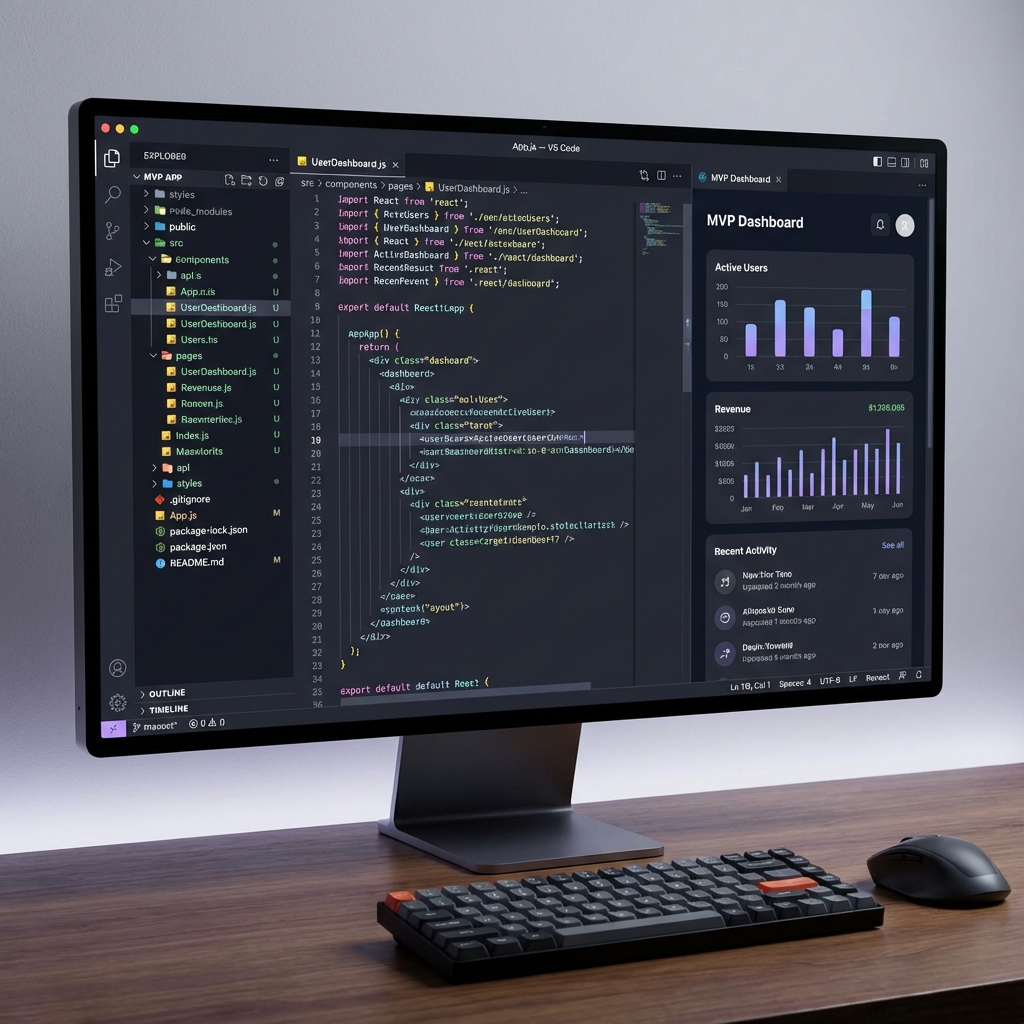Vibe Coder’s Guide to Building a Shippable MVP in 4 Hours


TLDR
You can now build a functional MVP in just 4 hours without writing traditional code. By using vibe coding—describing your app in plain English to AI tools—you can skip the setup, coding, and debugging phases. This guide shows you how to scope, build, and ship a "simple, practical, and shippable" MVP using tools like Bolt.new, Lovable, and Replit. Focus on one core feature, iterate fast, and get it into users' hands before lunch.
Table of Contents
- Step 1 — Define Your 4-Hour Scope
- Step 2 — Choose the Right Vibe Coding App
- Step 3 — Generate the First Version
- Step 4 — Add Real Functionality
- Step 5 — Improve Layout and Flow
- Step 6 — Connect Basic Data
- Step 7 — Review, Test, and Prepare
- Step 8 — Publish Your MVP
- Sample MVPs You Can Build in 4 Hours
- Realistic Expectations
- The 4-Hour Workflow Breakdown
- Avoid These Mistakes
- When to Move Beyond the MVP
- FAQs
Step 1 — Define Your 4-Hour Scope
Before you open any tool, you must define exactly what "shippable" means for you today.
A "Simple, Practical, and Shippable" MVP solves one specific problem for one specific user.
Do not build:
- A full SaaS platform with 5 user roles
- A social network with a feed and chat
- A marketplace with payments and reviews
Do build:
- A tool that takes an input and gives a valuable output
- A dashboard that visualizes one dataset
- A form that collects and organizes specific information
Write down your Core Value Proposition:
"My app helps [User] achieve [Goal] by [Action]."
Once you have this sentence, you are ready to choose your tool.
Step 2 — Choose the Right Vibe Coding App
Different tools fit different phases of the speed run.
Bolt.new — Best for instant MVP scaffolds
Why:
- Very fast generation
- Clean layouts
- Easy to tweak
- Good for demos and investor pitches
Perfect when: You need something visual immediately.
Lovable.dev — Best for beginners and visual thinkers
Why:
- Full apps from short prompts
- Predictable structure
- No technical knowledge required
Ideal for:
- Landing pages
- Dashboards
- Form-based MVPs
Cursor — Best for refining logic
Why:
- Deep reasoning
- Strong refactoring
- Good across many files
- Works well with existing Git repos
Perfect when: Your MVP grows and needs complex logic.
Replit — Best for deploying quickly
Why:
- AI built in
- Hosting included
- One-click deployment
- Great for sharing prototypes
Most vibe coders use:
Bolt.new → Cursor → Replit
or
Lovable.dev → Replit
Step 3 — Generate the First Version
Open your chosen vibe coding app.
Paste your prompt.
Generate the first draft.
You get:
- Screens
- Components
- Routing
- Forms
- Buttons
- Basic logic
- Placeholder content
This base version is enough to test your core idea.

Step 4 — Add Real Functionality
Once the base exists, you add the actions that matter.
Common MVP actions:
- Add an item
- Save a booking
- Submit a form
- Sort results
- Update an entry
- Filter by condition
- Show summary metrics
Examples:
- “Add form validation.”
- “Sort by date descending.”
- “Group tasks by category.”
- “Add a confirmation modal before deleting.”
The app updates instantly.
Step 5 — Improve Layout and Flow
You polish the app through short instructions.
Examples:
- “Make the layout two columns.”
- “Reduce spacing in the header.”
- “Use a softer colour palette.”
- “Align buttons to the right.”
- “Improve mobile layout.”
Vibe coding tools handle visual adjustments well.
Step 6 — Connect Basic Data
Many MVPs need simple data handling.
You can start with:
- Local state
- Temporary arrays
- Mock data
- Simple JSON files
If your MVP requires a small API:
- You can add it in Cursor
- You can attach it in Replit
- You can keep it simple (no databases needed)
Keep depth minimal.
MVPs test demand, not scalability.
Step 7 — Review, Test, and Prepare
Before publishing, check:
- Buttons
- Forms
- Navigation
- Layout
- Data input
- Error messages
- Flow from start to finish
Run through the app like a real user.
If something feels slow or unclear, fix it with one instruction.
Helpful internal links:
Step 8 — Publish Your MVP

The simplest publishing path:
Replit
- Deploy
- Share link
- Collect feedback
GitHub + Vercel
- For more control and cleaner hosting
Download + Custom Hosting
- Only needed when going beyond MVP
Your goal:
Get real users to try it within 4 hours.
Sample MVPs You Can Build in 4 Hours
Here are MVPs that vibe coding tools handle very well:
Business MVPs
- Appointment scheduler
- Invoicing tool
- Simple CRM
- Lead capture app
- Client dashboard
Consumer MVPs
- Habit tracker
- Budget tracker
- Workout planner
- Recipe organiser
SaaS MVPs
- Analytics dashboard
- Subscription calculator
- Content planning tool
- Notification system
Internal Tools
- Staff tracker
- Inventory manager
- Shift planner
These fit the 2–4 screen model and can be tested fast.
Realistic Expectations
A 4-hour MVP is:
- Functional
- Clear
- Focused
- Minimal
- Good enough to test
It is not:
- Polished
- Perfectly styled
- Optimised
- Complete
- Scalable for enterprise
The point is learning, not finishing.
The 4-Hour Workflow Breakdown
Hour 1 — Scope + Prompt
Define the core.
Write the prompt.
Generate the first version.
Hour 2 — Features
Add main functionality.
Fix flows.
Add or remove screens.
Hour 3 — Layout + UX
Improve visual design.
Fix spacing.
Optimise mobile layout.
Hour 4 — Deploy
Publish the app.
Share with early users.
Collect feedback.
This pattern fits most small MVPs.
Avoid These Mistakes
Mistake 1 — Too many features
MVPs test one thing.
Mistake 2 — Regenerating too often
Iterate instead of restarting.
Mistake 3 — Polishing too early
Ship first, refine later.
Mistake 4 — Forgetting the flow
Always test the full journey.
Mistake 5 — Building for all users
Start with one use case.
When to Move Beyond the MVP
Move forward when:
- People use it
- You receive clear feedback
- You see recurring requests
- You can describe a real next step
If users ignore it:
Substitute features.
Redefine the idea.
Or try a new MVP.
FAQs
1. Can I really build an MVP in 4 hours?
Yes. Many vibe coders do this weekly.
2. Which tool should I use first?
Bolt.new for speed.
Lovable.dev for simplicity.
Cursor for depth.
Replit for deployment.
3. Do I need coding experience?
Not for the MVP stage.
4. Can I publish it?
Yes. Replit works well.
5. What comes next?
Improve based on feedback.
Add structure in Cursor.
Scale your idea if it resonates.
About Vibe Coding Team
Vibe Coding Team is part of the Vibe Coding team, passionate about helping developers discover and master the tools that make coding more productive, enjoyable, and impactful. From AI assistants to productivity frameworks, we curate and review the best development resources to keep you at the forefront of software engineering innovation.



